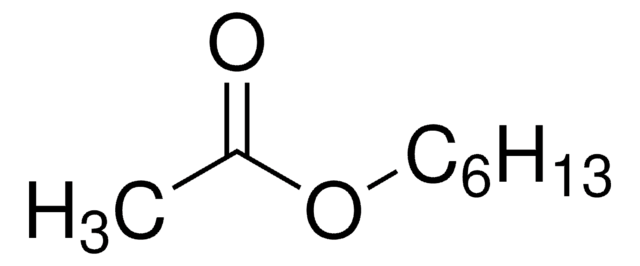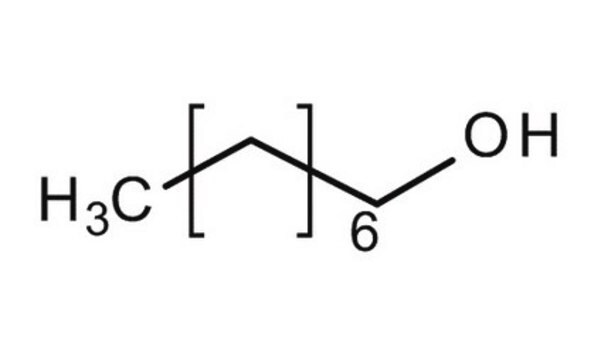All Photos(1)
About This Item
Linear Formula:
CH3(CH2)6OH
CAS Number:
Molecular Weight:
116.20
Beilstein:
1731686
EC Number:
MDL number:
UNSPSC Code:
12352100
PubChem Substance ID:
NACRES:
NA.22
Recommended Products
vapor pressure
0.5 mmHg ( 20 °C)
Assay
98%
form
liquid
autoignition temp.
662 °F
refractive index
n20/D 1.424 (lit.)
bp
176 °C (lit.)
mp
−36 °C (lit.)
density
0.822 g/mL at 25 °C (lit.)
SMILES string
CCCCCCCO
InChI
1S/C7H16O/c1-2-3-4-5-6-7-8/h8H,2-7H2,1H3
InChI key
BBMCTIGTTCKYKF-UHFFFAOYSA-N
Looking for similar products? Visit Product Comparison Guide
Related Categories
Application
1-Heptanol can be used:
- As a co-solvent in binary and ternary systems to estimate the liquid-liquid interaction parameters.
- In the synthesis of heptyl oleate ester from oleic acid.
- As a reducing agent in the synthesis of copper nanoparticles via hydroxyl ion-assisted alcohol reduction of copper salts in the presence of oleylamine.
Signal Word
Warning
Hazard Statements
Precautionary Statements
Hazard Classifications
Aquatic Chronic 3 - Eye Irrit. 2
Storage Class Code
10 - Combustible liquids
WGK
WGK 1
Flash Point(F)
168.8 °F - closed cup
Flash Point(C)
76 °C - closed cup
Personal Protective Equipment
dust mask type N95 (US), Eyeshields, Gloves
Choose from one of the most recent versions:
Already Own This Product?
Find documentation for the products that you have recently purchased in the Document Library.
Copper nanoparticles synthesized by hydroxyl ion assisted alcohol reduction for conducting ink
Huaman JLC, et al.
Journal of Materials Chemistry, 21(20), 7062-7069 (2011)
Liquid- liquid equilibria of the ternary system water+ acetic acid+ 1-heptanol
Aljimaz AS, et al.
Journal of Chemical and Engineering Data, 45(2), 301-303 (2000)
Screening and catalytic activity in organic synthesis of novel fungal and yeast lipases
Cardenas F, et al.
Journal of Molecular Catalysis. B, Enzymatic, 14(4-6), 111-123 (2001)
Density and viscosity of binary mixtures of {1-butyl-3-methylimidazolium thiocyanate+ 1-heptanol, 1-octanol, 1-nonanol, or 1-decanol}
Domanska U and Krolikowska M
Journal of Chemical and Engineering Data, 55(9), 2994-3004 (2010)
Nannan Ye et al.
Lab on a chip, 11(6), 1096-1101 (2011-02-05)
Transport across gap junction channels (GJCs) between neighboring cells is critical to synchronizing cell's electrical and metabolic activities and maintaining cell homeostasis. Here we present a non-invasive microfluidic method to measure molecular diffusion across GJCs in multiple 1D cell arrays
Our team of scientists has experience in all areas of research including Life Science, Material Science, Chemical Synthesis, Chromatography, Analytical and many others.
Contact Technical Service







